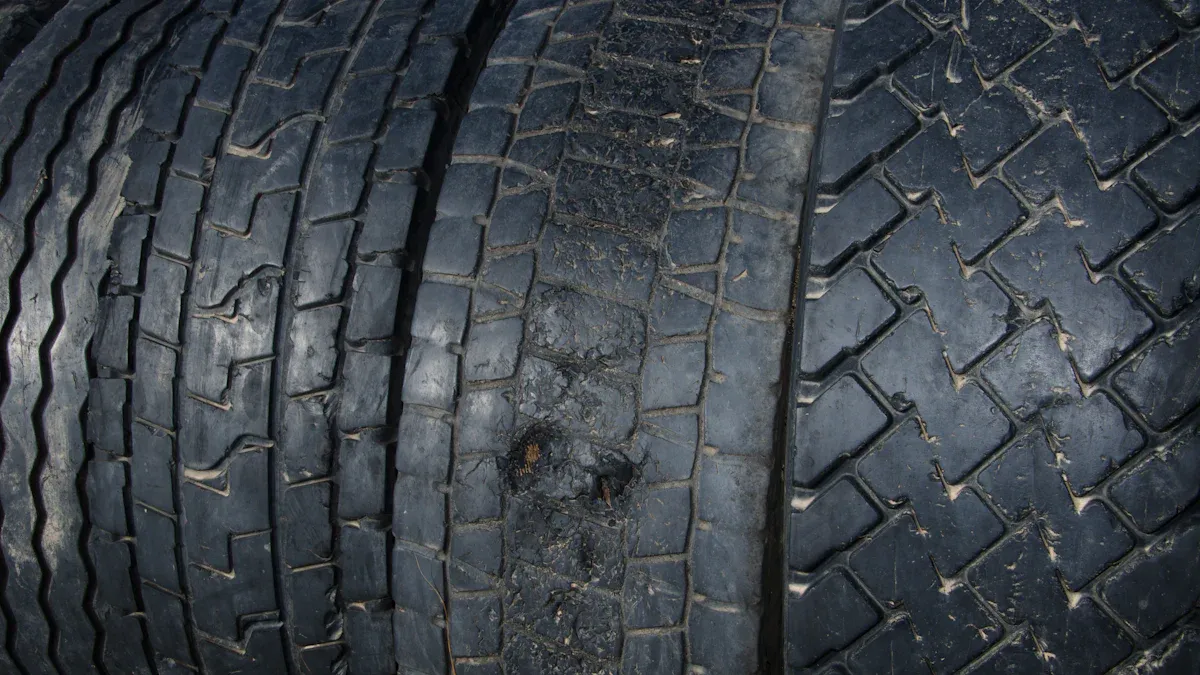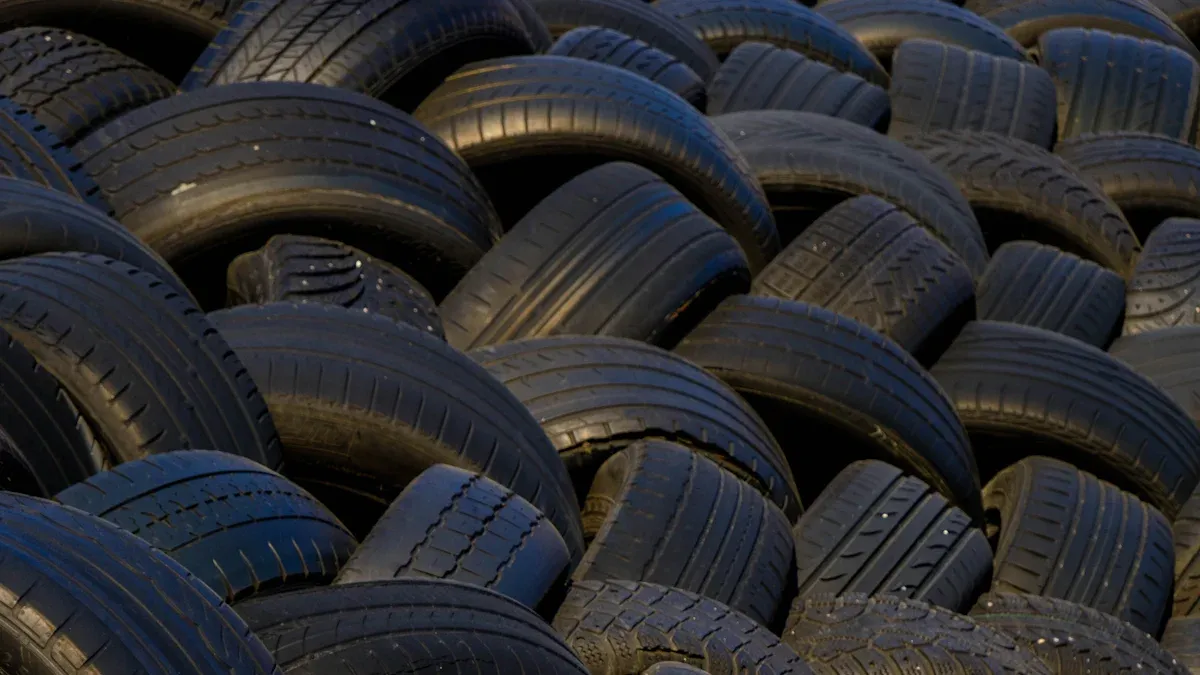
Tire health is very important for how your car works. Many drivers do not see how worn tires cause alignment problems. Ignoring this can create big issues later. Some people wrongly think alignment checks are just tricks to make money at repair shops. This can lead to risky choices. Also, some drivers believe tire rotation and alignment are not needed. They think alignments are only necessary when the car pulls to one side. Knowing these links is key for your safety and your car’s life.
Key Takeaways
Old tires can cause misalignment. This leads to uneven wear and shorter tire life.
Checking tires regularly helps find problems early. This makes driving safer and helps tires last longer.
You should get a professional alignment check at least once a year. This can stop expensive repairs.
Proper alignment makes your car use less gas. This saves you money on fuel over time.
Finding signs of misalignment early can help you avoid costly tire replacements. It also makes your ride smoother.
Tire Wear Basics
Causes of Tire Wear
Tire wear happens for many reasons. Knowing these reasons helps you take care of your tires. Here are some common causes of tire wear:
Over-Inflation Wear: This occurs when tire pressure is too high. It wears out the center of the tread.
Under-Inflation Wear: When tire pressure is too low, the edges of the tire wear out.
Feathering/Scuffing: This shows a bad toe angle, which can cause uneven wear.
Cupped/Scalloped Wear: Dips around the tread mean worn suspension parts.
Flat Spot Wear: Hard braking can create flat spots on the tire, hurting performance.
Wrong tire pressure and bad alignment can cause quick and uneven tire wear. Checking them often can help you avoid these problems.
Types of Tire Wear Patterns
Different tire wear patterns can show vehicle problems. Spotting these patterns helps you fix issues before they get worse. Here are some common tire wear patterns:
Center Wear: This pattern shows overinflation. It causes too much wear in the center, losing traction.
Edge Shoulder Wear: This means underinflation. It leads to faster wear on the edges from uneven weight.
Cupping/Scalloping Wear: This suggests possible suspension problems. Worn parts can make the tire move unevenly.
Patchy, Diagonal Wear: This might show tire imbalance, often from not rotating and balancing tires enough.
Knowing how worn tires cause alignment problems can help you avoid expensive repairs. Regular checks and maintenance keep your tires healthy and improve your vehicle’s performance.
How Worn Tires Cause Misalignment

What is Wheel Alignment?
Wheel alignment is about adjusting your car’s suspension system. This system connects your car to its wheels. Good alignment makes sure your tires touch the road at the right angles. When you drive, your tires should point straight and be parallel. If they aren’t, you might have misalignment.
Misalignment can happen for many reasons, including worn tires. When your tires wear unevenly, they can change the angles of your wheels. This can cause more misalignment, creating a cycle of problems. Before fixing anything, technicians check the suspension and steering parts. Worn parts can make it hard to align properly, causing uneven tire wear.
Effects of Alignment on Tires
Bad alignment can really affect how your tires work and last. Here are some main effects:
Uneven Tire Wear: Misalignment usually causes uneven wear on your tires. This can make some areas wear out faster, shortening your tires’ lifespan.
Reduced Fuel Efficiency: When your tires aren’t aligned right, your car has to work harder to move. This can lower fuel efficiency, costing you more money.
Handling Issues: Misalignment can make your car pull to one side. This makes it harder to steer and control, raising the chance of accidents.
Increased Stress on Components: Differences in tread depth can cause tires to rotate at different speeds. This creates extra heat and stress on parts of your car. Over time, this stress can lead to overheating and early wear of parts like the rear differential and transmission.
Regular alignment checks are important for keeping your tires lasting longer. Good wheel alignment is key for your car’s stability and tire health. Poor alignment causes uneven tire wear, which can greatly shorten tire life. Adding regular tire rotation and alignment to your maintenance can help your tires last longer.
Modern wheel alignment machines have improved a lot. They now have live feedback for measurements. As technicians adjust camber, caster, and toe, the changes show up on the screen right away. This allows for quick fixes and cuts down on constant checking.
By knowing how worn tires cause misalignment, you can take steps to keep your car healthy. Regular checks and good alignment help your tires stay healthy and boost your car’s performance.
Signs of Misalignment from Worn Tires

Uneven Tire Wear
You can often see misalignment problems by looking at uneven tire wear. This happens when your tires do not touch the road evenly. Here are some signs of uneven tire wear:
Tires wearing down faster on one side: If one side of your tire tread is much more worn than the other, this means misalignment.
Feather edge wear: This pattern looks ‘feathered.’ One side of the tire tread is smooth, while the other side is rough or raised. This pattern is often linked to misalignment issues.
Cupping or scalloping: If you feel bumps or dips on the tire surface, this can show suspension problems that lead to misalignment.
Ignoring these signs can cause more problems. You might have less traction, which can put your safety at risk on the road.
Steering Wheel Off-Center
Another clear sign of misalignment is a steering wheel that is off-center. When you drive straight, your steering wheel should be perfectly centered. If it tilts more than 5 degrees off center, you need to check your alignment. Here are some signs related to steering issues:
Shaky steering wheel: If your steering wheel shakes or vibrates, this can mean alignment problems.
Vehicle pulling or drifting: If your car moves left or right when driving straight, this shows alignment issues. You may have to keep correcting the steering to stay on track.
Worsening fuel efficiency: Misaligned tires make your engine work harder, which uses more fuel.
Regular alignments are suggested at least once a year to avoid these problems. Keeping your steering system in good shape improves your driving experience and keeps you safe on the road.
Impact of Misalignment | Description |
|---|---|
Handling | Unpredictable vehicle handling makes sudden moves more dangerous. |
Tire Wear | Uneven alignment causes tires to wear out early, lowering traction and raising blowout risk. |
Brake Efficiency | Misalignment leads to uneven brake pad wear, making stopping distances longer. |
By watching for these signs, you can fix misalignment problems early. This helps keep your vehicle’s performance and safety in good shape.
Consequences of Ignoring Worn Tires
Impact on Vehicle Handling
Not paying attention to worn tires can cause big problems with how your vehicle handles. Here are some long-term effects you might see:
Reduced Traction: Worn tires make it hard to grip the road, especially when it’s wet or snowy. This can make driving very risky.
Longer Stopping Distances: You might notice it takes longer to stop your car. This raises the chance of accidents, especially in emergencies.
Difficulty in Emergency Maneuvers: Worn tires make it tough to steer quickly in emergencies. You may find it harder to keep control, which can lead to losing control of your vehicle.
Ignoring tire care can also cause hydroplaning and worse vehicle handling. Checking your tires regularly can help avoid these dangerous situations and expensive repairs.
Cost of Premature Tire Replacement
Not fixing alignment problems from worn tires can cost you a lot. Here’s how ignoring these issues can hurt your wallet:
Frequent Tire Replacements: Worn tires wear out faster if they are misaligned. This means you will have to buy new tires more often, which costs more money.
Increased Accident Risk: Bad alignment can cause steering issues. This raises the chances of accidents, leading to costly repairs or insurance claims.
Higher Fuel Costs: Misaligned tires can waste fuel. Your vehicle has to work harder, which means you spend more on gas over time.
Regular tire care, like rotations and alignments, helps keep tires wearing evenly. This not only improves how your vehicle handles but also lowers the risk of alignment issues. By taking these steps, you can save money and stay safer on the road.
Preventive Measures for Tire and Alignment Health
Regular Tire Inspections
Checking your tires often is very important. It helps keep your tires and alignment in good shape. You should look at your tires at least once a month. Here are some reasons why these checks are important:
Identify Issues Early: Regular checks help you find problems like uneven wear or low pressure before they get worse.
Enhance Safety: Good tires help your vehicle grip the road better, especially when it’s wet.
Extend Tire Life: Watching tire wear can help you avoid changing them too soon.
For the best safety and performance, follow these tips:
Rotate your tires every 5,000 to 7,500 miles.
Look at tire pressure every week.
Importance of Professional Alignment Checks
Getting professional alignment checks is very important for your vehicle’s smooth running. You should have your alignment checked at least once a year or every 12,000 miles. Here’s why:
Prevent Uneven Tire Wear: Regular alignment checks help you avoid uneven wear, which makes your tires last longer.
Improve Fuel Efficiency: A misaligned vehicle can waste gas, lowering mileage by up to 10%. Proper alignment helps your engine work better.
Enhance Vehicle Handling: Good alignment helps your vehicle respond well, which is important for safety when driving fast.
Here’s a summary of preventive measures and their benefits:
Preventive Measure | Benefits |
|---|---|
Stops costly repairs later on. | |
Makes rides smoother and safer. | |
Finds misalignment issues early, saving money on replacements. |
By making regular tire inspections and professional alignment checks a priority, you can keep your vehicle safe and working well. These steps not only save you money but also make your driving experience better.
Taking care of your tires and keeping them aligned is very important for how well your car works and how safe it is. Here are some important points to remember:
Misalignment can cause tires to wear unevenly and wear out faster.
Checking wheel alignment regularly makes your car safer and easier to handle.
Good alignment helps save gas, which saves you money over time.
Spotting signs of misalignment early can help you avoid expensive tire replacements.
By being proactive, like doing regular checks and alignments, you can stop problems from worn tires. Make sure to take care of your car to have a safer and better driving experience. 🚗✨
FAQ
What causes tire misalignment?
Tire misalignment usually happens when you hit potholes, curbs, or drive on bumpy roads. Worn suspension parts can also cause this problem. Checking your tires regularly helps you find these issues early.
How often should I check my tire alignment?
You should check your tire alignment at least once a year or every 12,000 miles. If you see uneven tire wear or have steering problems, check it sooner.
Can I fix misalignment myself?
You can look at your tires for wear, but fixing misalignment needs special tools. It’s best to go to a professional mechanic for correct adjustments.
How do I know if my tires are worn?
Check for uneven tread wear, cracks, or bumps on the tire surface. If your tires feel flat or your car pulls to one side, they might be worn.
What are the benefits of regular tire maintenance?
Regular tire maintenance makes driving safer, improves fuel efficiency, and helps tires last longer. It also ensures better handling and lowers the chance of accidents on the road. 🚗✨
See Also
The Importance Of Monitoring Tire Tread Depth For Safety
Steps To Effectively Utilize A Tire Tread Depth Gauge
Understanding Smart Tire Tread Depth Detectors And Their Function






